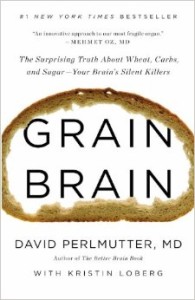
In the midst of the current gluten-free craze meets return-to-evolutionary eating Paleo diet fad, Markham Village Naturopathic Clinic decided to dedicate this month’s Health and Wellness Book Club to Dr. David Perlmutter’s Grain Brain: The Surprising Truth About Wheat, Carbs, and Sugar – Your Brain’s Silent Killers.
Dr. Perlmutter begins by comparing the current Western diet – composed of primarily of carbohydrates (60%) and moderate amounts of protein and fat (approximately 20% each) – to the ancestral diet on which we evolved – composed primarily of fat (75%), a moderate amount of protein (20%) and minimal amounts of carbohydrates (a meager 5%). He contends that this significant dietary shift – from a predominantly fat-fueled metabolism to a predominantly carbohydrate-fueled one – is responsible for much of the chronic illnesses facing society today, from diabetes to Alzheimer’s and cardiovascular disease to cancer.
While Dr. Perlmutter goes on to focus primarily on the effects of this dietary change on brain health, his central tenant is that a carbohydrate-based metabolism leads to inflammation in the body, which leads to pathology and disease. This is because the building blocks of carbohydrates are sugars, and sugars (in large quantities) tend to wreak havoc on our systems by promoting oxidative stress – a biological type of “rusting.”
Sugar can be thought of as a rambunctious puppy – in need of boundaries and supervision. Few of us would allow an unsupervised puppy to have free reign of a house filled with fragile valuables. In an attempt to avoid a ravaged house of broken knick-knacks, furniture-turned-chew toy, and puddles of suspicious canine surprises, puppy is either under the watchful eye of a responsible owner or given some toys and confined to a puppy-proofed room.
Sugar has the same destructive tendencies as an untrained puppy. If allowed free reign of our bodies – and particularly our blood stream – it acts as a reactive oxygen species that bounds around the house, oxidizing whatever it comes in contact with and leaving a trail of inflammation in its wake. Luckily, our bodies come equipped with their own supply of responsible owners (aka insulin) and puppy-proofed rooms (aka our cells). From the time the puppy comes tearing through the front door, insulin rises and swiftly transports him past the fine china and into our cells. It’s a finely tuned system that effectively minimizes the damage-potential of sugar while still allowing us to enjoy its benefits.
Trouble arises when we have more rambunctious puppies than we do responsible owners. At first, insulin doubles its efforts, recruits friends to help and runs itself into a frenzy chasing after way-ward mess-makers, but at some point – I’d imagine after finding themselves standing amid the shambles of chaos and destruction – our overwhelmed responsible owners pitch in the towel and let the dogs have their day.
We have long known that it is this mechanism that leads to type II diabetes, but recent research is showing that high blood sugar levels are also implicated in brain disease, cardiovascular disease, high cholesterol, cancer and aging. Conversely, while the wisdom of the past few decades has taught us that dietary fats are the enemy, causing everything from obesity to atherosclerosis, the research doesn’t support this. In fact, more and more studies are showing the immense health benefits of a high-fat diet. Even cholesterol, which has been the target of many nutritional and pharmaceutical cardiovascular disease interventions, is beginning to emerge as a wrongfully-accused victim. Beyond not being a negative indicator of health, recent studies have shown high cholesterol to be associated with lower all-cause mortality and lower incidents of brain disease. It seems that much of what we previously attributed as the ill-effects of fats are actually the ill-effects of sugar, and how nutrients (including fats) are processed in a high-sugar environment.
- Carbohydrates are composed of sugars, which require the action of insulin in order to be properly utilized in our body. When our carbohydrate and sugar intake overwhelms our body’s ability to handle it, we increase the likelihood of inflammation and oxidative damage to our bodies.
- While reverting to the 5% carbohydrate intake of our ancestors might be a little extreme, a balanced diet that is lower in carbohydrates (and particularly simple carbs) is likely to be the most health-friendly.
- Fats are friend, not foe! When we’re cutting back on carbohydrate intake, the best source to replace those calories – for your waistline, your body and your brain – are (healthy) fats.


Leave a Reply